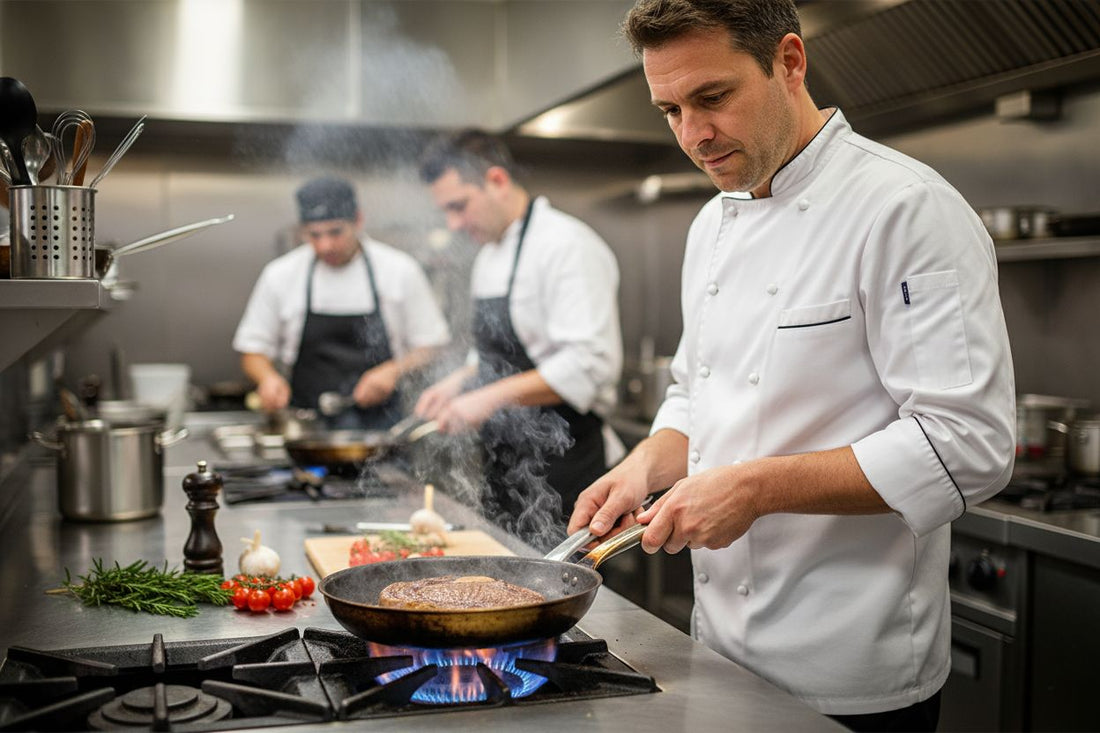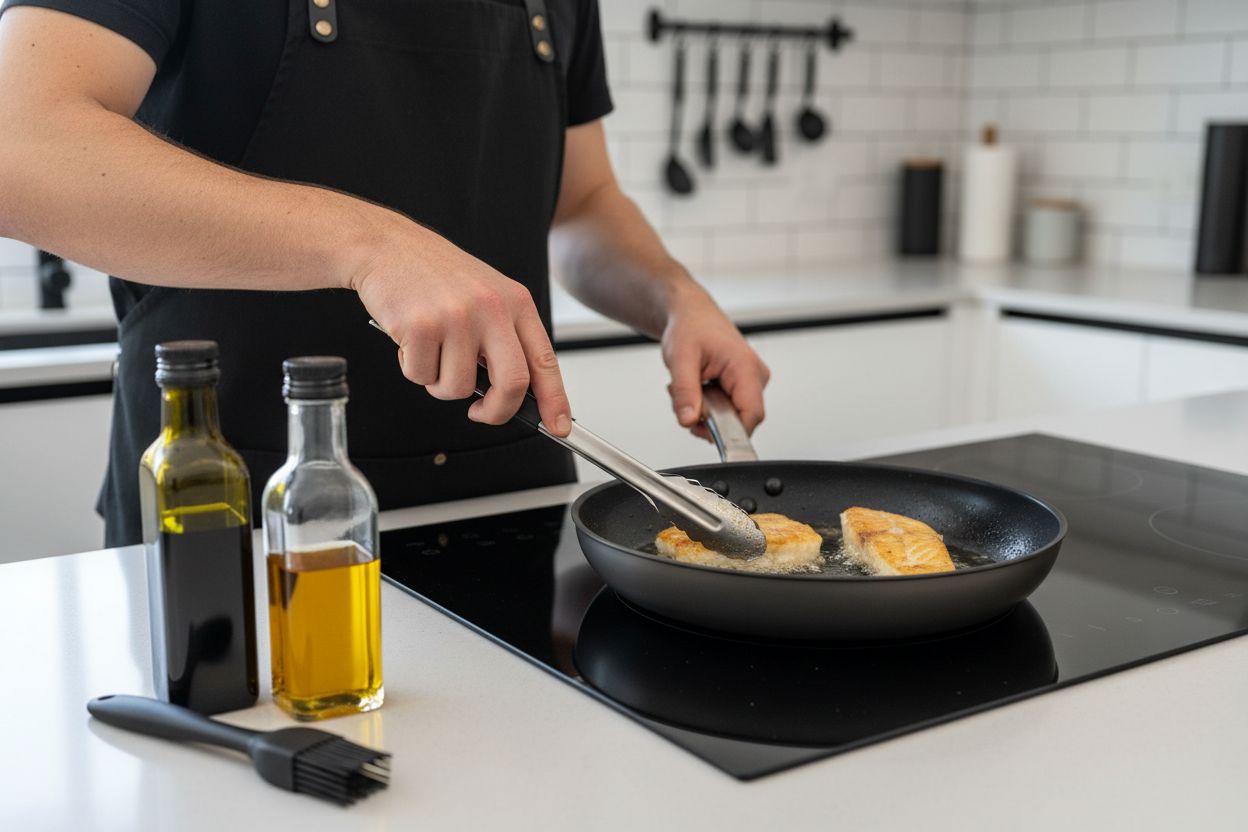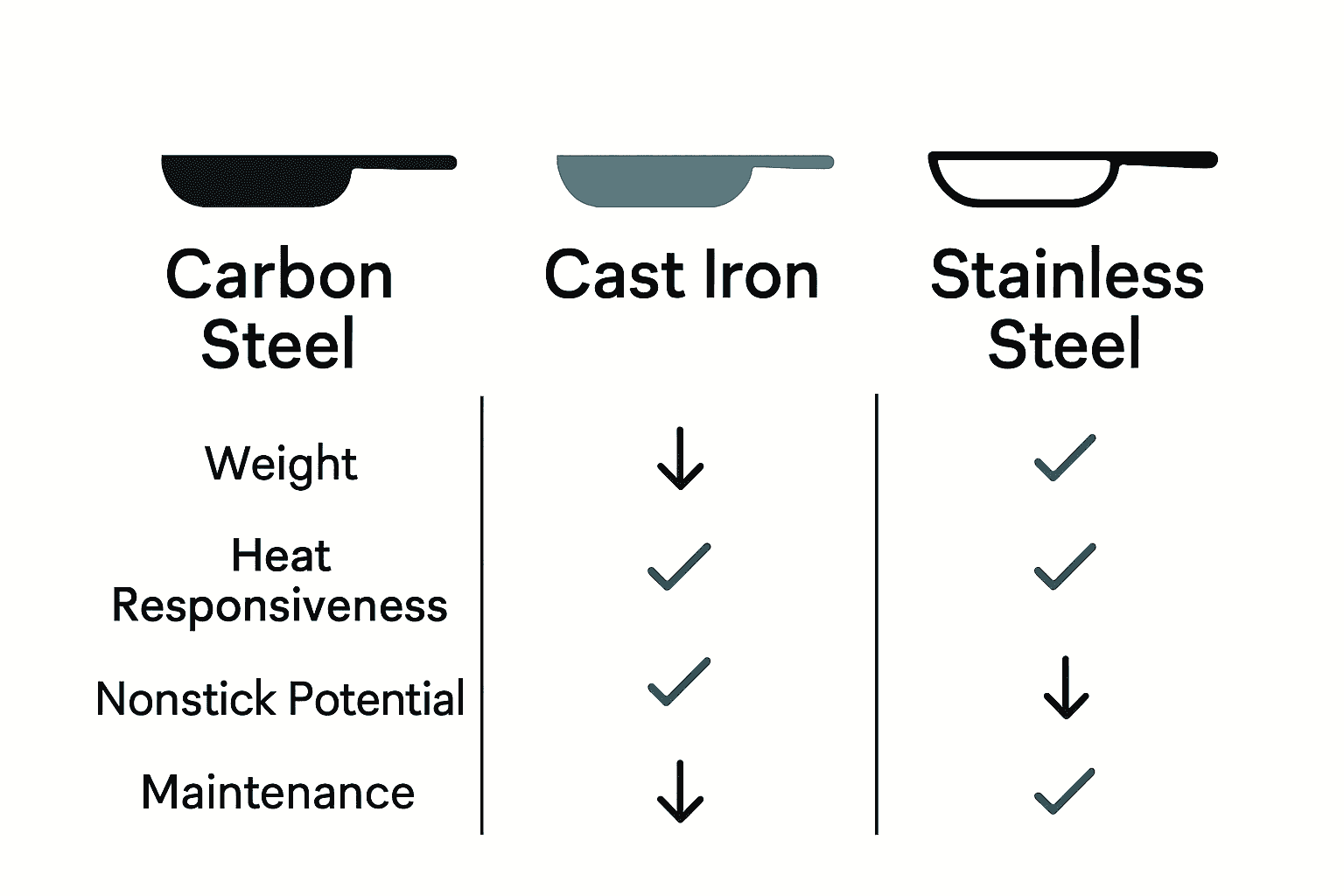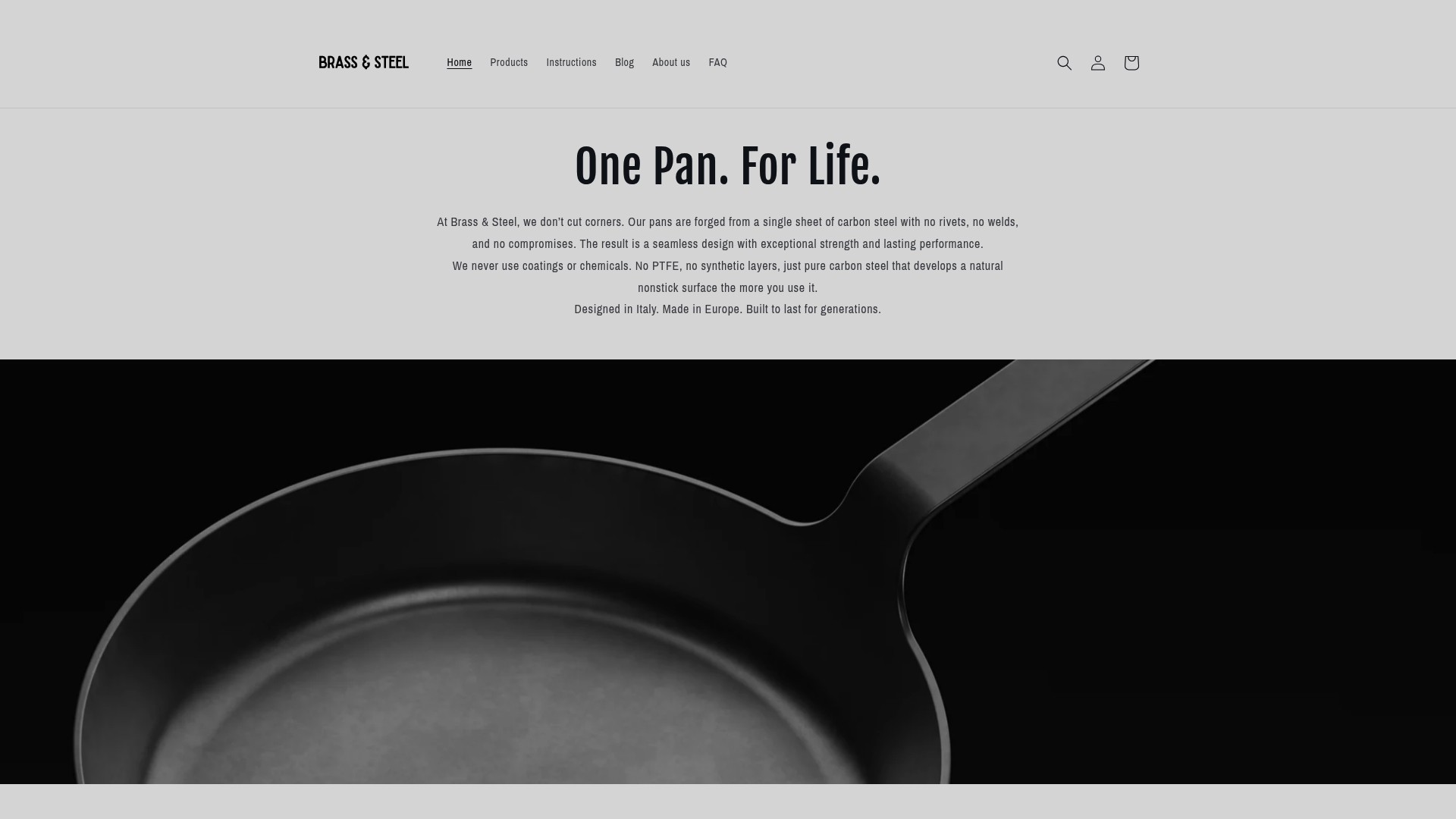
Complete Guide to the Culinary Benefits of Carbon Steel
Share
Over 80 percent of professional chefs choose carbon steel pans for their kitchens because of its unbeatable heat control and natural nonstick qualities. Many home cooks are now discovering how this durable material can completely change the way they cook. With its rapid temperature response and a surface that gets better with time, carbon steel reveals new possibilities for anyone serious about making restaurant-quality meals at home.
Key Takeaways
| Point | Details |
|---|---|
| Superior Performance | Carbon steel cookware offers exceptional heat conductivity and responsiveness, making it ideal for precise cooking techniques. |
| Natural Nonstick Surface | Proper seasoning develops a natural nonstick layer that improves with use, providing a safer alternative to chemical-coated cookware. |
| Versatility and Durability | Suitable for both stovetop and oven use, carbon steel is lightweight yet durable, enhancing cooking efficiency across various methods. |
| Health-Conscious Choice | Free from synthetic coatings, carbon steel ensures minimal risk of harmful chemical leaching during high-temperature cooking. |
Table of Contents
- Defining Carbon Steel In Culinary Use
- Performance Benefits For Cooking Enthusiasts
- Seasoning And Natural Nonstick Properties
- Health And Safety Considerations For Chefs
- Comparing Carbon Steel To Other Cookware
Defining Carbon Steel in Culinary Use
Carbon steel is a unique culinary material that transforms the cooking experience through its remarkable heat conductivity and versatile performance. According to research from metalworking studies, carbon steel cookware is crafted by rolling or hammering dense metal sheets, creating an incredibly robust cooking surface designed for professional and home kitchens alike.
Unlike other cookware materials, carbon steel requires a specific preparation process called seasoning. As research indicates, this process involves creating a polymerized oil patina that yields a low-tack surface perfect for achieving exceptional browning and Maillard reactions. Understanding why professional chefs use carbon steel reveals that this unique characteristic makes it ideal for techniques demanding precise heat control.
Key characteristics of carbon steel cookware include:
- Exceptional heat distribution
- Rapid temperature responsiveness
- Natural nonstick surface when properly seasoned
- Durability that improves with proper maintenance
- Versatility across stovetop and oven cooking methods
While traditional cookware often requires complex maintenance, carbon steel offers a straightforward approach. By understanding its fundamental properties and embracing proper seasoning techniques, home cooks and professional chefs can unlock a cooking surface that becomes more refined and performant with each use.

Performance Benefits for Cooking Enthusiasts
For passionate home cooks and professional chefs, carbon steel offers an unparalleled cooking experience that transforms culinary techniques. Understanding carbon steel cookware performance reveals why this material has become a secret weapon in professional kitchens worldwide.
The performance benefits of carbon steel are remarkable and multifaceted. Its exceptional heat conductivity allows for rapid temperature changes, enabling precise cooking control that other materials simply cannot match. Chefs appreciate how carbon steel pans heat evenly, creating perfect sear marks on meats and achieving ideal caramelisation for vegetables with minimal effort.
Key performance advantages include:
- Superior heat retention
- Rapid temperature responsiveness
- Incredible durability that improves with use
- Lightweight compared to cast iron
- Naturally developing nonstick surface
Whether you’re searing a delicate fish fillet, creating a perfect steak crust, or preparing a delicate sauce, carbon steel adapts to your cooking style.
Its ability to withstand high temperatures and transition seamlessly from stovetop to oven makes it an incredibly versatile tool for cooking enthusiasts who demand both performance and precision.
Seasoning and Natural Nonstick Properties
Seasoning transforms carbon steel from a raw metal surface into a culinary marvel, creating a remarkable natural nonstick coating that gets better with each use. Ultimate carbon steel pan seasoning guide provides insights into how this unique process develops a protective layer that enhances cooking performance.
The seasoning process involves polymerizing oil molecules onto the pan’s surface, creating a hard, slick coating that prevents food from sticking and protects against rust. This natural nonstick surface develops gradually, unlike chemical coatings that deteriorate over time. Professional chefs appreciate how carbon steel pans become more nonstick with repeated use, developing a smooth patina that actually improves cooking results.
Key aspects of carbon steel’s natural nonstick properties include:
- Develops a protective layer through repeated cooking
- Becomes more nonstick with proper maintenance
- Eliminates need for synthetic chemical coatings
- Provides superior food release as seasoning builds
- Improves cooking performance with each use
Maintaining this nonstick surface requires minimal effort. Regular cooking with oils, proper cleaning, and occasional re-seasoning ensure your carbon steel pan continues to develop a robust, naturally slick surface that makes cooking easier and more enjoyable. The result is a cooking tool that becomes truly personalized to your culinary style.
Health and Safety Considerations for Chefs
Carbon steel cookware represents a significant advancement in health-conscious cooking, offering professional chefs a safer alternative to traditional nonstick surfaces. Health & safety benefits of carbon steel pans highlight the critical advantages of choosing this innovative cooking material.
Unlike conventional nonstick pans that rely on synthetic chemical coatings, carbon steel provides a naturally occurring nonstick surface without potential health risks. The seasoning process creates a protective layer that prevents direct metal contact with food, eliminating concerns about harmful chemical leaching. Professional chefs appreciate that carbon steel pans are free from PFOA, PTFE, and other potentially toxic substances found in traditional nonstick cookware.
Key health and safety advantages include:
- No synthetic chemical coatings
- Natural polymerized oil surface
- Eliminates risks associated with traditional nonstick pans
- Supports high-temperature cooking safely
- Minimal metal ion transfer during cooking
Maintaining your carbon steel pan’s safety involves proper seasoning, careful cleaning, and avoiding extreme temperature changes. By following simple care instructions, chefs can ensure their cookware remains a reliable, health-conscious tool in the kitchen. The result is a cooking surface that not only performs exceptionally but also prioritizes the well-being of those preparing and enjoying the meal.
Comparing Carbon Steel to Other Cookware
Professional chefs and cooking enthusiasts continuously seek the most effective cookware, and carbon steel stands out as a remarkable alternative to traditional materials. Understanding iron vs carbon steel for culinary use reveals the unique advantages that set this material apart from conventional cooking surfaces.
Unlike cast iron, which is heavy and slow to heat, carbon steel offers superior heat responsiveness and lighter weight. Compared to stainless steel, carbon steel provides better heat distribution and develops a natural nonstick surface through seasoning. Nonstick pans with synthetic coatings quickly deteriorate, whereas carbon steel actually improves with repeated use, creating a more durable cooking surface that professional kitchens demand.
Key comparative advantages include:
- Lighter weight than cast iron
- More responsive heat distribution than stainless steel
- Natural nonstick surface without chemical coatings
- Improves with consistent use
- Versatile across multiple cooking techniques
While each cookware material has its strengths, carbon steel represents a perfect balance of performance, durability, and health-conscious cooking. Its ability to adapt to various cooking styles makes it a superior choice for chefs who demand precision, reliability, and exceptional culinary results.

Here’s a comparison of carbon steel, cast iron, and stainless steel cookware:
| Feature | Carbon Steel | Cast Iron | Stainless Steel |
|---|---|---|---|
| Weight | Lightweight | Heavy | Moderate |
| Heat Responsiveness | Very responsive | Slow to heat/cool | Moderately responsive |
| Natural Nonstick Surface | Develops with seasoning | Develops with seasoning | No natural nonstick |
| Durability | Improves with use | Extremely durable | Highly durable |
| Cooking Versatility | Stovetop Oven |
Stovetop Oven |
Stovetop Oven |
| Maintenance | Regular seasoning Minimal effort |
Regular seasoning More effort |
Low |
| Chemical Coatings | None | None | None |
| Weight vs. Performance | Light, high performance | Heavy, high performance | Medium, good performance |
Elevate Your Cooking with Carbon Steel Precision
If you have learned about the culinary advantages that carbon steel brings – from rapid heat responsiveness to a natural nonstick surface – you may still be facing the frustration of unreliable pans or coatings that wear out quickly. The guide has shown how professional-grade carbon steel cookware can transform home and restaurant kitchens alike, yet the search for truly durable and health-conscious alternatives is often overwhelming. Experience the confidence that comes from cookware engineered for performance and crafted to last. For those ready to commit to their best culinary results, explore our complete Carbon Steel Collection designed for both everyday cooking and demanding professional use.

See the difference our single-piece construction makes, combining heirloom quality with a minimalist design that performs on any hob – including induction. Now is the time to upgrade your pans with Brass & Steel and discover why serious cooks are turning to our professional carbon steel cookware for unparalleled heat control and kitchen reliability. Explore our collection today and give your kitchen the foundation it deserves.
Frequently Asked Questions
What is carbon steel, and how is it used in cooking?
Carbon steel is a versatile cookware material known for its exceptional heat conductivity and ability to develop a natural nonstick surface when properly seasoned. It is commonly used by both professional chefs and home cooks for various cooking methods, including stovetop and oven techniques.
How do I season a carbon steel pan?
To season a carbon steel pan, apply a thin layer of oil to the clean, dry surface and heat it until the oil starts to smoke. This process polymerizes the oil, creating a protective layer that enhances nonstick properties. Regular cooking and proper maintenance will improve the seasoning over time.
How does carbon steel compare to cast iron and stainless steel cookware?
Carbon steel cookware is lighter than cast iron and more responsive to heat. Unlike stainless steel, which does not develop a natural nonstick surface, carbon steel becomes increasingly nonstick with seasoning. It offers a balance of performance, weight, and durability that is advantageous in various cooking techniques.
What are the health and safety benefits of using carbon steel pans?
Carbon steel cookware is free from synthetic chemical coatings, which can be found in traditional nonstick pans. The seasoning process creates a safe, natural nonstick surface, eliminating concerns about harmful chemical leaching during cooking. Proper care also ensures minimal metal ion transfer during food preparation.